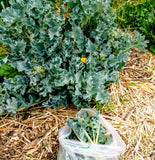
If you know me at all as a gardener, you know that I’m a huge sea kale advocate. Every year I save bundles of root cuttings for recruitment of new sea kale converts, in hope that we can complete the work that Thomas Jefferson began long ago.
 Sea kale, Latin name Crambe maritima, was one of Thomas Jefferson’s favorite vegetables - one that he planted at Monticello over 200 years ago. A native of the rocky coasts of Europe, sea kale is one of the most reliable, prolific green vegetables you will ever know. While its historic range might be harsh, sea kale is just as happy in well mulched, slightly alkaline, soil.
Sea kale, Latin name Crambe maritima, was one of Thomas Jefferson’s favorite vegetables - one that he planted at Monticello over 200 years ago. A native of the rocky coasts of Europe, sea kale is one of the most reliable, prolific green vegetables you will ever know. While its historic range might be harsh, sea kale is just as happy in well mulched, slightly alkaline, soil.
There are so many fun facts about sea kale that I created a top 10 list of reasons to love it. So, here it goes...
10. Sea kale prevents scurvy. Scurvy is caused by severe lack of vitamin C, a vital component in the production of collagen, the glue that holds us together. In areas plagued by war and famine, scurvy is still a serious concern.
9. Sea kale is hardy from USDA Hardiness Zone 8 to Zone 4, or even 3, depending on who you ask. This means that it can be grown throughout most of the United States and Europe.
8. Sea kale has edible roots. Because I prefer to share my extra root stock, I have never tried eating them, but the folks on Cultivariable have written a nice, introduction to preparation techniques.
7. Sea kale can be easily propagated with roots. While growing from seed can be challenging, root propagation of sea kale is a breeze. The roots, known stirringly as "thongs", are planted with their smaller end downward. Each cutting will form a new plant, which generally takes two years to mature.
6. Sea kale is an efficient groundcover. Although not technically a spreading plant, sea kale grows large enough to become a thick, high groundcover. I have had healthy plants grow as large as 5 feet in diameter.
5. Sea kale flowers are an early pollinizer food. If you let sea kale flower, it will create hundreds of flowers at a time when pollinizers are often hungry for nectar. In my zone (6b) they usually blume by mid May.
4. Sea kale has crunchy, delicious spring leaves. The early leaves of the sea kale plant are crisp, succulent, and refreshing. These are available in profusion well before most other spring vegetables.
3. Early spring sea kale shoots are treated as a delicacy in Europe. These shoots are grown under "blanching pots", to shield them from the sun and preserve their delicate flavor.
 2. Flower buds from sea kale beat broccoli in side-by-side taste tests every time (at least in my house). These buds appear in early May in my region. They can be nearly as thick as broccoli, except that the stalk is as delicious as the buds. The entire vegetable is sweeter and milder than its doppelganger cousins. I am not entirely certain why anyone still grows broccoli!
2. Flower buds from sea kale beat broccoli in side-by-side taste tests every time (at least in my house). These buds appear in early May in my region. They can be nearly as thick as broccoli, except that the stalk is as delicious as the buds. The entire vegetable is sweeter and milder than its doppelganger cousins. I am not entirely certain why anyone still grows broccoli!
And, the number 1 reason that I love sea kale is.... wait for it...
1. Sea kale is perennial for up to 10 years! If you make a habit of digging up the roots, as I do, you will always have new scions. It is nearly impossible to remove all of a root from the soil. The remaining bit will form a brand new sea kale plant!
So there you have my top 10 list of reasons to love sea kale. If you are interested in trying some, you can often find seeds online. Take care with young seedlings, as they are quite delicate. Once they have survived the first season, they should be with you for a very long time.
